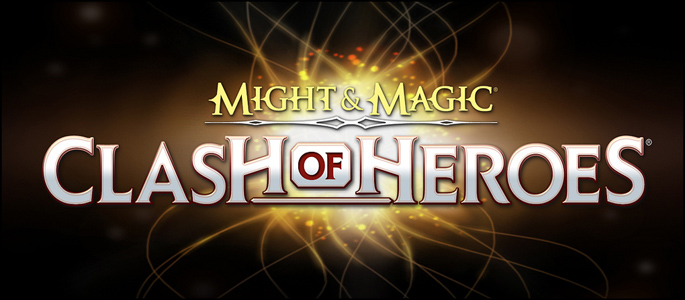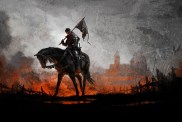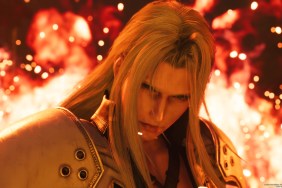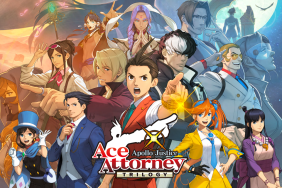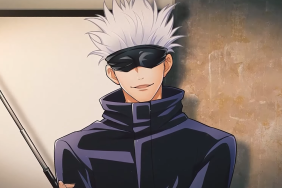Might and Magic is one of the oldest RPG series, having been around since the 1986 when the original title, The Secret of the Inner Sanctum, debuted on the NES, the Commodore 64 and old DOS systems. The first created a huge following and inspired a number of direct sequels until the company, 3DO, closed their doors and the rights to the name were passed along. Enter a new era of various spin-offs, alterations, side games and a name slapped on anything vaguely related with role playing elements. Might and Magic: Clash of Heroes was originally a Nintendo DS game released in 2009 that left the strict RPG standards behind to create a story based puzzle fighter. After much critical acclaim, an HD port was issued to be developed on the PSN and XBLA. The pieces are in the right place, but does the jump between the portable world to your living room guarantee the same experience?
Might and Magic: Clash of Heroes delivers a play style similar to Puzzle Quest, but unlike Puzzle Quest because you’ll actually want to play it (zing!). You’ll enter the world of Ashan that avid fans of the M&M series will recognize from Heroes of Might and Magic V. The campaign begins with some powerful figures gathering in a forest to discuss plans to further protect the world from the Blade of Binding enter the hands of the demon forces, but as expected, they show up to crash the party, kill most of the guardians, and in the end, the blade goes missing. During this moment of confusion, the children of these guardians run for safety by diving into a portal which sends each of them to a different sections of the world. The campaign is then played out through these 5 character’s separate stories as they rid each of the lands they’re thrust in of its evil and try to make it back together before the sword ends up in the hands of the Demon Lord.
M&M‘s gameplay consists of moving around the glyph points on the map, talking to NPCs in between the puzzle battles you’ll encounter, story based or otherwise. Battles take place on an imaginary grid split in half with your enemy on the further side, and you in the foreground. Your playing field will be littered with troops differing in color and types which must be reorganized into like-colored sections to create attack squads or walls of defense. Your goal is to direct enough attacks past the enemy units which will deal damage to your opponent’s lifebar. Units do not attack immediately though as they require a certain amount of turns to charge up their strength completely.

Immediately it becomes apparent that strategy is at the heart of the game, and playing through a round with a tough computer or smart foe will often feel like a game of chess. Matching unit’s charge times against enemy formations, preparing future attacks, and building up walls to defend from onslaughts are the necessary skills you’ll need to adapt into your playing style. You could attempt to power through the enemy by only lining up attack formations, but most likely, your opponent will take note and build to counter, only to strike when your line is undefended and scattered.
To add some more pizzaz to your army, your army can be outfitted with up to 2 hero types. Hero units require you to sacrifice your basic troops for their attack, but it’s worth it. They deliver special attacks that can cause some serious damage and bring new offensive strategies. For instance, while a basic soldier charges for 2 turns and attacks for 5 damage, a Knight (hero) requires a longer charge time, but can deal up to 30 damage, almost guaranteeing you will cause direct damage on your opponent’s lifebar. Hero units usually carry an additional effect, such as being impervious to attacks while charging, or even draining the life of your enemy’s HP into your own. Play with them in your lineup, and there’s no going back. These special troops force you to begin thinking like a pro as you’ll soon find yourself creating attacks 3 turns in advanced in your head.

With a campaign that can charge the completionists of the world up to 40 hours of their life, things could get pretty repetitive. Amazingly though, the game keeps every fight fresh and new. You’re encouraged (or forced) throughout the entire game to adopt new strategies as win objectives change and you discover new heroes with which to experiment. It’s almost as if the designers implemented chapter ends and introduced you to the next playable character right when this familiarity sets in, but the change is very natural as it keeps the game from stagnating. These 5 campaign characters each control separate armies and have unique abilities, including one final move and a special wall type. For instance, Anwen is a forest elf and leads an army that plays heavily on a nature theme. Her defensive walls are vines that have the ability to keep growing stronger with each passing turn, and her final attack is a barrage of arrows shot in a direction of your choosing. Fiona, on the other hand, is an underworld character with zombies and skeletons at her command. Her walls are made from the bones of each of her defeated troops, and her final move, ‘Blood Sacrifice’, instantly kills all of her idle troops in order to power one large attack. The level of diversity these different boards, characters, and moves create makes for some great variety in play styles and individual techniques. Considering how much there is to experiment with, and the fact that we haven’t even touched on game changers like artifacts, linking and fusion, it’ll be a while before you get bored with the game.
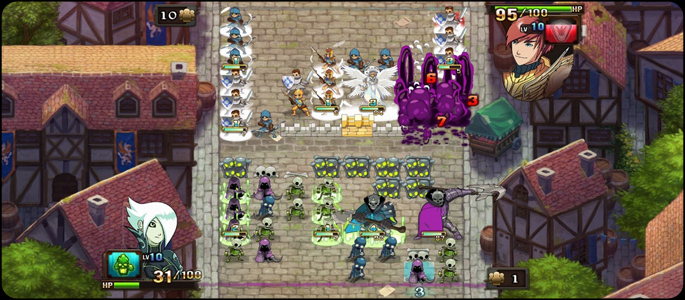
When you’ve had your fill of overpowering the computer, step into multiplayer and note the game taking a drastic change. Instead of facing a cunning, yet still brainless computer who can miss large plans you may be conjuring, you now have a living, breathing human sitting opposite you, keeping you on your toes and turning each battle into a test of wits. Exciting isn’t accurate enough, and fun is too shy of a word: this multiplayer is a blast. I will be the first to admit my hesitations stepping in. Ditching the 4 second turns the computer takes, and facing the inevitable online “all I do is play this game, so you’ll leave crying” guy had me worried I’d find the first flaw in Clash of Heroes, but instead a whole new world of challenge opens, pinning all your training into a real match in a 1 v 1 battle or, if you really want to get your money’s worth, team up with another player and head into a 2 v 2 match.
You and your teammate will share a space, but will have separate characters that can be used together for attacks. It’s a little confusing to start, but after a few turns, you’ll be up to speed as you’re fusing attacks and building walls alongside a real partner. What sets the whole multiplayer over the top though is the inclusion of voice chat. Creating attack patterns, formulating long-term strategies and deciding how best to use your combined 6 initial moves adds limitless depth to the game when you can simply discuss it with your partner rather than relying on crossed fingers and prayers. Mind you, this is online play so your opponents will most likely take the opportunity to do nothing more than insult you and distract you with obscenities, however to say it doesn’t add a competitive flair to the mix up would be a bold-faced lie. On another note, all of the matches I played, no matter how competitive and insulting, ended with everyone congratulating each other on the great fight, which was rewarding on its own.
Clash of Heroes made a risky move from the portable realm to the downloadable market on a home console, but it’s one of those games where the developer never really had to worry that this dramatic jump; it was practically a guaranteed success. After all, how could one of the Nintendo DS’s best reviewed games receive an HD face lift and an incredible new online element and not deliver? The publishers knew they were making a wise choice putting money into expanding the audience, and thank your gods they did, because we now have our chance to play through a title that over delivers on almost all fronts. Clash of Heroes offers some fantastic game mechanics, a decent story and enough variety to keep you coming back to see it through to the end. Fans of the genre and series should absolutely give this one a try, it may just become the staple title for future puzzle-battle games.
PlayStation LifeStyle’s Final Score
+ Large variety and multiple characters keep the gameplay fresh + Online multiplayer adds a new challenge. Co-op battles must be experienced |
 |
–
